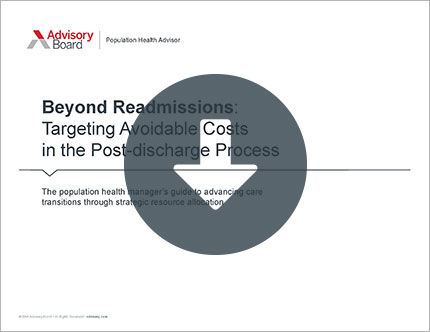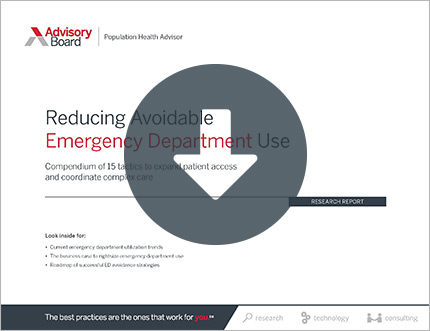Auto logout in seconds.
Continue LogoutRead Advisory Board's take: The important question this analysis raises
While the reduction in Medicare readmissions under the Hospital Readmissions Reduction Program (HRRP) initially may have "seemed like the win-win that policymakers had" sought, "a deeper look at [HRRP] reveals a few troubling trends" that should be scrutinized, a trio of cardiologists and health policy researchers write in a New York Times opinion piece.
The authors are Rishi Wadhera, a cardiology fellow at Harvard Medical School; Karen Joynt Maddox, a cardiologist at the Washington University School of Medicine; and Robert Yeh, a cardiologist and director of the Smith Center for Outcomes Research in Cardiology at Beth Israel Deaconess Medical Center.
How HRRP works
HRRP was created in 2010 under the Affordable Care Act to reduce the number of preventable Medicare readmissions. At the time, about half of Medicare 30-day readmissions were thought to be preventable, the authors write. As such, "reducing hospital readmissions was seen by policymakers as a rare opportunity to improve the quality of care while reducing costs."
CMS launched HRRP in fiscal year 2013, and hospitals began to face financial penalties for high rates of 30-day readmissions for patients who'd been hospitalized with pneumonia, heart attack, or heart failure. The program has since undergone some changes. Most recently, CMS for FY 2019 implemented a new penalty determination methodology, which is intended to soften penalties for hospitals that serve large populations of low-income patients.
A closer look
"At first," the authors write, HRRP appeared to be working, as "[r]eadmission rates declined nationwide for target conditions," resulting in Medicare saving an estimated $10 billion.
However, upon closer scrutiny, the program appears to correlate with "a few troubling trends," the authors note. For instance, they note that since HRRP took effect, patients who return to the hospital "are more likely to be cared for in [EDs] and observation units." This "raised concern that some hospitals may be avoiding readmissions, even for patients who would benefit most from inpatient care," the authors write.
Another "troubling trend," according to the authors, is that "safety-net hospitals with limited resources have been disproportionately punished by the program." These hospitals' patient populations tend to have lower incomes and "are at much higher risk of readmission." The financial penalties on these hospitals in particular, "may impede their ability to deliver good care," the authors write.
The 'most concerning' evidence
Further, the authors write that the "most concerning" trend surrounding HRRP is that "there is growing evidence that while readmission rates are falling, death rates may be rising."
The authors point to a recent study they authored based on data between 2005 and 2015 that found HRRP "was associated with an increase in deaths within 30 days of discharge among" pneumonia and heart failure patients. The authors wrote that deaths among heart failure patients, which were increasing before HRRP took effect, increased more once the program was created. In addition, pneumonia deaths, which had been stable before the program took effect, increased once it started.
The authors add, "For both conditions, the increase in deaths after the program were concentrated in those patients who had not been readmitted to the hospital after discharge." The authors contend, "If we assume that the program was directly responsible for these increases in mortality and that prior trends would have continued unabated, the program may have resulted in 10,000 more deaths among patients with heart failure and pneumonia."
The authors acknowledge that another recent study found "that although deaths after discharge were increasing for heart failure and pneumonia, they did not accelerate under the program." The authors of that study, the op-ed authors note, "argue that other changes could have been responsible for the trend, such as an increase in the medical complexity of patients."
A call for more analysis
While MedPAC in its June 2018 report to Congress concluded that the HRRP has not contributed to higher 30-day mortality rates and recommended expanding the program, the opinion piece authors write that CMS should first thoroughly investigate the matter.
"All possibilities should be considered, from coding changes to inappropriately turning patients away from the emergency room to changes in risk factors among Medicare patients," they write, adding, "While the problem is complex, the short-term answer is simple—err on the side of caution," (Wadhera et al., New York Times, 12/21/18; Firth, MedPage Today, 6/15/18).
Advisory Board's take
Eric Fontana, Managing Director, Data and Analytics Group and Kenna Hawes, Senior Data Analyst, Data and Analytics Group
The Wadhera et al study is the latest in a succession of studies that have raised questions about whether CMS' Hospital Readmission Reduction Program is unintentionally harming Medicare patients. The latest study comes on the heels of a Congressionally mandated June 2018 report by the Medicare Payment Advisory Commission (MedPAC), which concluded that the HRRP has not contributed to higher utilization of the ED or observation status, and that it has not contributed to higher 30-day mortality rates. It's not yet clear whether MedPAC will respond to this latest study, or if Congress will ask the commission to study the issue further.
“It's not yet clear whether MedPAC will respond to this latest study”
It's also worth noting that CMS has adjusted the HRRP's assessment methodology for 2019 in an attempt to make the program's policies more fair to hospitals that serve more complex patient populations. However, this change did not address what some providers see as the central problem of the program: It discourages hospitals from readmitting patients with target conditions (heart failure, COPD, and others).
In our opinion, the most interesting question asked by the authors of this latest study is: "Why are policies that profoundly influence patient care not rigorously studied before widespread rollout?" We've heard this question asked of many of CMS' other payment and delivery innovations over the past few years, including bundled payment schemes and public reporting of health care quality metrics. It will be interesting to see whether this latest study prompts further Congressional examination of CMS' payment and delivery innovation activities – especially given that the Trump administration has stated it intends to roll out further reforms through this avenue.
To see how your hospital is impacted by the HRRP, find your FY 2019 results in our interactive map below. And make sure you stay tuned for our combined FY 2019 Pay-for-Performance analysis when CMS releases results for the Hospital-Acquired Condition (HAC) Reduction Program in February.
Get your cardiovascular readmission reduction toolkit
Reducing your hospital's readmission rates can seem like an overwhelming task—but it doesn't have to be.
Knowing where to focus is half the battle. We've found that the best strategies target four stages of care with significant potential to influence cardiovascular patient outcomes. The other half is knowing what improvements to make.
That's where our Readmission Reduction Toolkit comes in. We've compiled resources from across Advisory Board that will help you isolate and correct patient and systemic issues in the four critical stages of care.
Don't miss out on the latest Advisory Board insights
Create your free account to access 1 resource, including the latest research and webinars.
Want access without creating an account?
You have 1 free members-only resource remaining this month.
1 free members-only resources remaining
1 free members-only resources remaining
You've reached your limit of free insights
Become a member to access all of Advisory Board's resources, events, and experts
Never miss out on the latest innovative health care content tailored to you.
Benefits include:
You've reached your limit of free insights
Become a member to access all of Advisory Board's resources, events, and experts
Never miss out on the latest innovative health care content tailored to you.
Benefits include:
This content is available through your Curated Research partnership with Advisory Board. Click on ‘view this resource’ to read the full piece
Email ask@advisory.com to learn more
Click on ‘Become a Member’ to learn about the benefits of a Full-Access partnership with Advisory Board
Never miss out on the latest innovative health care content tailored to you.
Benefits Include:
This is for members only. Learn more.
Click on ‘Become a Member’ to learn about the benefits of a Full-Access partnership with Advisory Board
Never miss out on the latest innovative health care content tailored to you.


